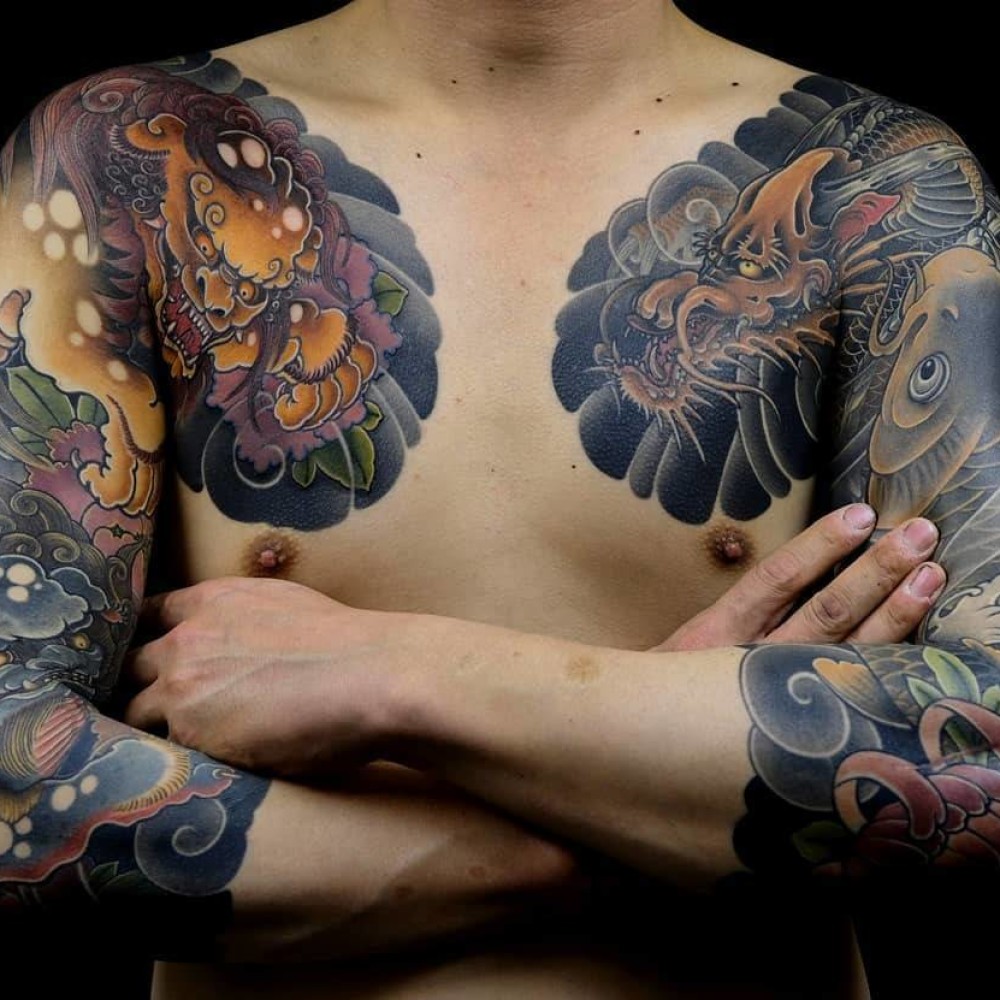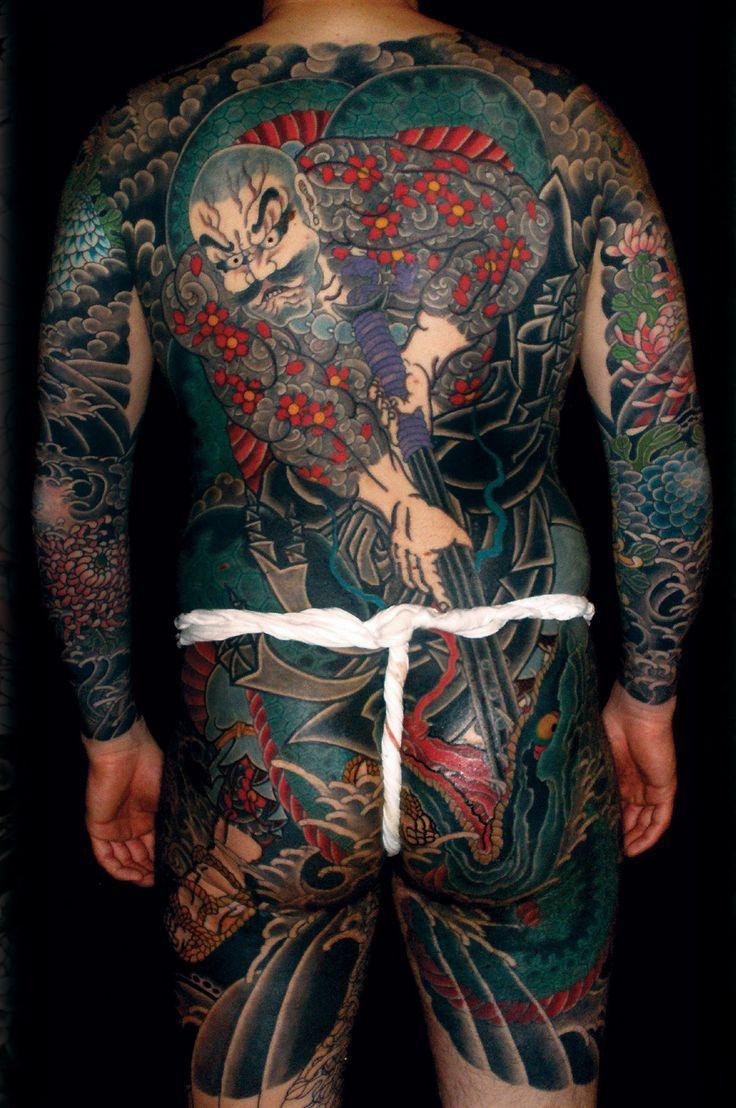
Pin on Irezumi 刺青 Japanese tattooing
Japanese Irezumi is a traditional form of body art that uses dark ink to create beautiful designs on the skin. This practice goes back centuries, with its origins rooted in religious rituals, spiritual beliefs, and decorative elements. The meaning and message of an irezumi design can be monumental, ranging from honoring Japanese gods and.

TatMasters Lees alles over Japanese (Irezumi) tattoos
Irezumi (入れ墨, lit. 'inserting ink') (also spelled 入墨 or sometimes 刺青) is the Japanese word for tattoo, and is used in English to refer to a distinctive style of Japanese tattooing, though it is also used as a blanket term to describe a number of tattoo styles originating in Japan, including tattooing traditions from both the Ainu people and the Ryukyuan Kingdom.

Pin by dfenzi on Tattoos Japanese tattoo, Japanese sleeve tattoos
04 November 2016. Irezumi is both the verb and noun tattoo. Tattoos have been used in Japan for centuries as both decoration and as a form of punishment (bokkei). Explore Japanese irezumi from its humble beginnings to the present. Traditionally, irezumi were applied with hand tools — this was known as tebori.

My fav irezumi, just the right shading and perfect colour Irezumi
Irezumi Symbology. Until the Edo period in Japan (1600-1868) tattoos, world wide, were done with marks and symbolism rather than imagery. It was in Japan, in the Edo period, that "decorative" tattoo began to develop into the advanced art form it is known as today. The Traditional Japanese Tattoo "Irezumi" is the decoration of the body.

Japanese Tattoos Irezumi of the Yakuza TatRing
Irezumi ( 入れ墨 , lit. 'inserting ink') (also spelled 入墨 or sometimes 刺青) is the Japanese word for tattoo, and is used often to refer to a very distinctive style of Japanese tattooing, however, it is also used as an overarching term to describe many Japnese tattoo styles, including tattooing traditions from both the Ainu and the.

horimono Japanese tattoo, Irezumi tattoos, Sleeve tattoos
The common term for Japanese tattoo art is irezumi (入れ墨), meaning to insert ink. This refers to the Japanese tattooing tradition of inserting ink beneath the skin to form the tattoo. Irezumi tattoos derive inspiration from Japanese folklore and mysticism. The most common tattoos are Koi Fish, Samurai, Dragons, and Oni.

Horimono Irezumi Traditional japanese tattoo my work artist🔀
The current stigma behind tattoos, or irezumi, stems from criminal associations with the term from the past. "Irezumi" (入れ墨) literally means "inserting ink". The term refers to a traditional style of Japanese tattoos created using tebori - a tool that has a wooden or metal handle attached to a needle via a silk thread.

Pin on H
Kian Forreal works under the Traditional Japanese Tattoo name of HORISUMI and specialises in Hand -carved Traditional Japanese Tattooing also known as 'Horimono' 'Irezumi' or 'Wabori'. He works exclusively in the traditional hand poke method of Japanese tattooing called 'Tebori' having studied extensively in Japan under a master of the.

Oni Irezumi Wallpapers Top Free Oni Irezumi Backgrounds WallpaperAccess
Oct 2, 2023 - Explore Bardadim Tattoo's custom Japanese tattoos, blending tradition with modern elements. Discover the history of Irezumi, different tattoo designs, and experience Gakubori and Nukibori. Trust us for a unique Japanese tattoo experience.

Pin on Under My Skin
Irezumi is a common name for Japanese tattooing in the western part of the globe. Even though this word, which means to inset ink, is Japanese, it is widely believed that the term isn't the appropriate name for what is known today as old-style Japanese tattoos. Horimono, or image carving, is the proper name for the aesthetic style of.

u/paatizz93 great sleeve. r/irezumi Japanese tattoo women, Tattoos
A peony tattoo has many meanings that range from bravery, courage, honor, good fortune, romance, and prosperity. One of the most beautiful motifs of Japanese tattoos, a botan tattoo, or peony tattoo, is a wonderful addition to any Irezumi collection. Read more: The Imperial Peony - Traditional Japanese Tattoos of Botan

Pin van Geert op Irezumi japanese tattoo in 2020
Irezumi is derived from the Japanese words 'ireru' and 'sumi', meaning 'to insert' and 'ink' respectively. This term broadly refers to the art of creating tattoos, originally using traditional hand-poked methods. It contains an implicit social context derived from the Yakuza and the criminality of tattoos between 1872 and 1948.

Japanese Irezumi Tattoo Meanings Irezumi Traditional Japanese Tattoo
Japanese tattoo style, also known as Irezumi, Wabori, or Harimono, is a traditional art form with deep cultural roots and a rich history. Originating in Japan, this style features bold motifs, detailed imagery, and vibrant colors that capture the essence of its meaningful symbolism. Drawing inspiration from historical events, mythology, and.

14.8k Likes, 101 Comments Japanese Ink (japanese.ink) on Instagram
The main reason for the ban is that tattoos, known as irezumi in Japanese, have long been associated with criminal gangs, or yakuza. In the postwar era, a government movement to mobilize businesses to stop all dealings with gangs led bathhouses and other establishments to display signs or stickers banning yakuza and, by extension, people with.

Japanese tattoo sleeve by horitaka_tattoo. japaneseink
In the 18th century, Japanese tattoos underwent yet another transformation. Due to the prevalence of the colorful and pictorial Ukiyo-e woodblock print, tattoos rendered in this style became popular among groups of people with lower social statuses, like laborers, peasants, and even gangs.Given its ties to the lower class and its long and unsavory history, Irezumi was eventually outlawed in.

Japanese Tattoos Cloak and Dagger Tattoo Parlour London
Japanese tattoos, known as "Irezumi" in Japan, are more than mere decorations on the skin; they are a reflection of a complex cultural narrative interwoven with history, belief, identity, and artistry. This research article sets out to unravel these complexities, offering readers a panoramic view of a subject that has captivated imaginations and provoked debates across centuries.